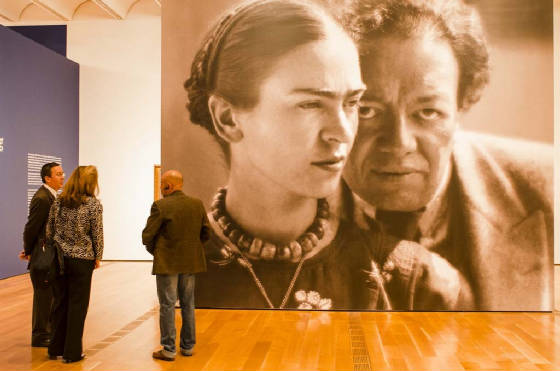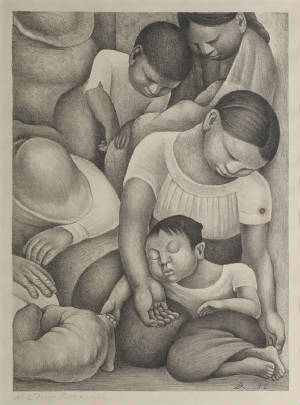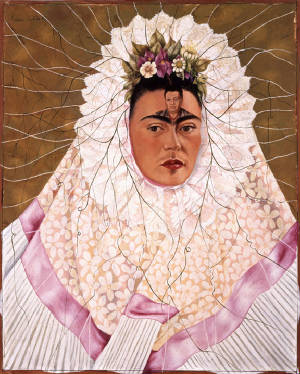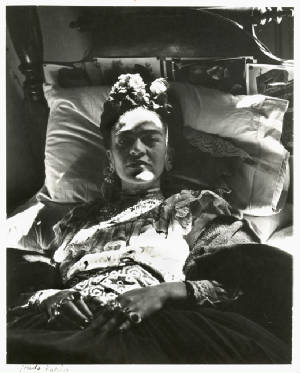|

|
| Installation View, Frida and Diego, High Museum of Art, Atlanta © Virginie Kippelen 2013. |
Dr. Elliott King is an Assistant Professor of Art History and Washington and Lee University (please visit his website at spiralspecs.com). His research focuses
on Surrealist art and thought with an emphasis on the post-war art and writing of Salvador Dalí. In 2010, Dr. King was Guest
Curator of the critically acclaimed exhibition, Dalí: The Late Work, at the High Museum of Art in Atlanta, Georgia
(catalogue published by Yale University Press, 2010). He has returned to the High Museum as the Guest Curator of Frida & Diego: Passion, Politics, and Painting at the High Museum of Art in Atlanta from February 14, 2013 – May 12, 2013. He and TAS Editor-in-Chief Deanna
Sirlin exchanged thoughts by email.
Deanna Sirlin: Do you think Diego and Frida influenced each other in the studio?
Elliot King:
Curating this exhibition, I heard time and time again that Diego influenced Frida but not vice versa. I understand why one
would think that looking at the work, but I’m not convinced it’s so one-sided. In the exhibit, we have Frida’s
1929 painting, The Bus, and it’s clear in that painting that she had already begun to incorporate elements of Diego’s
social realism just a year after they met. You specifically ask about their interactions in the studio: Each was often present
while the other was working, and I can easily imagine Diego offering suggestions while Frida painted. To be honest, she probably
took most of them; he was, after all, twenty years older and one of the most famous artists in Mexico when they met. His style
was established by the late-1920s whereas hers was only blossoming, and naturally she looked up to Diego and probably acted
on a lot of his advice. That’s not to say she was only derivative, of course, but his influence was very strong. I actually
don’t imagine Frida giving Diego artistic guidance in the same way. I’m not sure he would have taken it. Still,
I cannot believe a couple would be together for twenty-five years and the influence would go in only one direction. They shared
life circumstances, and he was constantly around her paintings; there has to have been some effect on his paintings as well
as hers.
DS: In retrospect who is the more important artist, in the sense of influencing
the next generation of artists?
EK: Perhaps it’s telling that when the Mexico
City-based design consultancy THiNC (Ignacio Cadena and Héctor Esrawe) came aboard to design the show’s reading rooms,
they pulled their inspiration from specifically Frida’s diaries and imagery from her paintings, not Diego’s; there’s
just something about Frida that seems to connect with people today – much more so than Diego.
With that
in mind, my first reaction would be to speculate that Frida will hold the greater influence on the next generation of artists.
I will probably get feedback to the contrary, but that’s my opinion. It’s partially due to accessibility: Diego’s
public murals are basically limited to San Francisco, Detroit, and Mexico City, so it’s much harder to get a sense of
his work without going to those cities and seeing his murals in person. Today, we’re more likely to look at art on a
screen than go on a pilgrimage to see a wall mural, and frankly Diego’s frescoes need to be seen in person to be really
appreciated. Even his easel paintings – particularly his Cubist paintings – are much different in person and really
don’t translate well through electronic media. By contrast, Frida’s paintings are more easily disseminated and
digested. They have a smooth finish, so brushstrokes aren’t lost in reproduction. Greenberg would have said that’s
a bad thing, obviously, but I think it helps account for her present-day iconic status and the impact I suspect her work will
have on contemporary artists.
Frida also strikes me as more connected to contemporary
theory than Diego. She has been adopted by feminist scholarship and LGBT studies, whereas Diego’s paintings seem to
me to be more intrinsically rooted to their particular time and political circumstance; one might say his works are more historical
and hers more timeless. Frida executed her share of hammers and sickles as well, but most of those paintings are in the collection
of the Casa Azúl and consequently can’t be lent to outside exhibitions, meaning they’re much less well-known than
her other self-portraits. Again it becomes an issue of accessibility.
I don’t want to
discount Diego. I’m purely speculating about the near-future of contemporary art given present-day concerns, which tend
to favor ready dissemination and marketability over explicit social and political narrative. Perhaps future critics will look
back on the twentieth century and recognize Diego as one of the singular great masters. Certainly one of his legacies should
be that he was one of the first to bridge art and political activism. And importantly, he was doing it in a public space.
The idea of creating art that was accessible to people outside the museum – of democratizing art by bringing it out
of gallery, to the people – influenced many late twentieth-century artists who defied traditional exhibition spaces
to ‘take to the streets’. I’m not just speaking of the 1960s Chicano Mural Movement, which looked consciously
to ‘los tres grandes’ – Diego, David Alfaro Siquieros, and José Clemente Orozco; I think one could make
convincing case to connect Diego’s Mexican muralism with elements of contemporary street art. Especially when it’s
blown up to the level of international politics…say, Banksy’s public murals on Israel’s West Bank barrier
– I actually think there’s a lot of Diego Rivera in that work. 
Diego Rivera (Mexican, 1886
– 1957), El Sueño (La Noche De Los Pobres) (Sleep (The Night of the Poor)), 1932, lithograph on paper, Collection
of Museo Dolores Olmedo, Xochimilco, Mexico. © 2012 Banco de México Diego Rivera Frida Kahlo Museums Trust, Mexico, D. F.
/ Artists Rights Society (ARS), New York.
DS: Was Frida a Surrealist? How was she different from other surrealists?
EK:
I oscillate on this question day-to-day. To summarize, in 1938, the Surrealists’ leader and chief theorist, André Breton,
visited Mexico and ‘discovered’ Frida’s painting during a visit with Leon Trotksy, who was then living with
Frida and Diego. Seeing her emotional self-portraits, he proclaimed her as a Surrealist ‘despite the fact that [her
paintings] had been conceived without any prior knowledge whatsoever of the ideas motivating the activities of my friends
and myself.’ Breton then organized Frida’s first solo exhibit in New York at the Julien Levy Gallery, a well known
gallery for Surrealist art. For her part, Frida exhibited as a Surrealist, and both she and Diego were featured in the 1940
International Surrealism Exhibit in Mexico City. Only later did she reject the Surrealist label, saying that Surrealism was
about dreams whereas her work depicted her own reality.
Frida’s
disavowal of Surrealism based on dream imagery isn’t that clear. Surrealism is rightly associated with dreams, but that’s
because Surrealist painting is more about process than product. To be Surrealist, the process has to be one that delves into
the subconscious – ‘free of aesthetic and moral considerations’, as Breton wrote in the Surrealist Manifesto
of 1924. Dreams were one area – for a long time, the main area – the Surrealists explored to tap into the subconscious,
but certainly by 1938 it wasn’t the only style of Surrealist painting. The more telling issue, really, is to what
extent Frida’s process was Surrealist. This may be overly pedantic, but it’s an interesting question. Clearly
she wasn’t deliberately aiming for the Freudian subconscious; her style was already rooted in Mexican indigenous art
well before she met Breton, and it was only to an outsider like Breton that her fantastic imagery could have been feasibly
identified as Surrealistic. This would be the argument that she wasn’t really a Surrealist and that Breton ‘mis-labelled’
her. On the other hand, Breton had already identified a number of artists as Surrealist in spirit – Picasso among them
– and he may well have recognized a ‘savage eye’ in Frida’s work, too. I suppose keep going back to
Breton’s definition of Surrealism as ‘Pure psychic automatism, by which it is proposed to express – verbally,
in writing or by any other means – the true functioning of thought. The dictation of thought, in the absence of all
control exercised by reason, and outside all aesthetic or moral considerations.’ Here he doesn’t explicitly say
a Surrealist has to be aiming to tap the subconscious – only that he or she must endeavour to express ‘the true
functioning of thought’ without any moral or aesthetic filter. If that’s our bar, I think we can say that Frida
was expressing her own personal thoughts in the most raw, direct form of which she was capable. She once wrote, ‘I never
knew I was a Surrealist until André Breton came to Mexico and told me I was. The only thing I know is that I paint because
I need to, and I paint always whatever passes through my head, without any other consideration.’ That process –
painting whatever passes through one’s head without consideration – is the definition of Surrealism, even if she
didn’t think of herself as part of the group.

Frida Kahlo (Mexican, 1907–1954), Autorretrato como Tehuana (Diego en mi Pensamiento)
(Self-Portrait as Tehuana (Diego in My Thoughts)), 1943, oil on masonite, The Jacques and Natasha Gelman Collection of
Mexican Art. © 2012 Banco de México Diego Rivera Frida Kahlo Museums Trust, Mexico, D. F. / Artists Rights Society (ARS),
New York.
DS: Do you
think there was an aspect of performance to the way Frida and Diego dressed and behaved as “artists”?
EK:
Both Frida and Diego were acutely aware of their public images. The earliest Diego work we have in the show is a self-portrait
from 1907, and even at that young age, he’s playing a part – a young artist with a beer, smoking a pipe in a darkly
lit corner of a bar. Neither Frida nor Diego could have been in the public eye as much as they were and be ignorant of their
presentation, which I think we can certainly call ‘performance’. I’m thinking mainly of the way Frida dressed,
by the way. In terms of behavior, I’m not sure they were behaving in a particularly ‘artistic’ manner, to
be honest. If we’re talking about the various extra-marital affairs each of them had, for instance, I wouldn’t
call that behaving as an artist, necessarily, and would find it more intriguing to connect their open marriage to Karl Marx’s
disapproval of monogamy. It seems like sort of a cop out to say they were just ‘behaving like artists’.
DS:
Surrealism is part of Modernism; however Modernism is a movement of the past that has ended. Surrealism is still part of contemporary
art. Can you explain why this happened?
EK: I’m not sure ‘modernism is a movement
of the past that has ended,’ even if one were to take the position that contemporary art is in an age of post-modernism
(or post-post-modernism?). Certain ideas of modernism are deeply engrained, even when contemporary art and theory seeks to
overturn them. I’m also hesitant to identify Surrealism as ‘part of contemporary art’ without nuance: Surrealism
as a movement is still very much alive (despite having been declared ‘dead’ countless times over the decades),
but while there are Surrealist groups and, within those, Surrealist artists working today, most of Surrealism’s influence
on contemporary art is historical and conceptual. No major contemporary artists would describe themselves as Surrealists,
just as I suspect no major artists would call themselves modernists. Yet there are both Surrealists and what we might call
‘modernists’ out there. If the question becomes, then, why Surrealism continues to hold an influence today more
so than, say, AbEx, I’d offer that it has to do with the qualities that made Surrealism distinct even in the 1920s and
1930s – its interest in popular culture, exploration of multiple viewpoints and perspectives undermining fixed signifiers,
privileging of the viewer, and interest in spectator experience. Surrealism simply has more in common conceptually with postmodernism.
DS:
Do we have a parallel of a couple in the public eye like Diego and Frida?
EK: I don’t
know who it would be. Some people have compared them to Georgia O'Keeffe and Alfred Stieglitz, Christo and Jeanne-Claude,
or Claes Oldenburg and Coosje van Bruggen, but Frida and Diego were different from all these. They weren’t collaborators
in the sense of Christo and Jeanne-Claude or Oldenburg and van Bruggen. They were also much more in the public eye than these
couples – so much so that one could try comparing them instead to contemporary celebrities, but that wouldn’t
do justice to their political activism. Maybe if Bono and Ali Hewson had a more tumultuous marriage…? I’m just
going to have to go with no.
Frida Kahlo (Mexican, 1907–1954),
El Abrazo De Amor De El Universo, La Tierra (México), Diego, Yo Y El Señor Xólotl (The Love Embrace of the Universe, the
Land (Mexico), Diego, Me, and Señor Xólotl), 1949, oil on masonite, The Jacques and Natasha Gelman Collection of Mexican
Art. © 2012 Banco de México Diego Rivera Frida Kahlo Museums Trust, Mexico, D. F. / Artists Rights Society (ARS), New York.
DS: Why does our culture like this kind of drama for its artists?
EK: Our culture likes drama in general, doesn’t it? Perhaps expectations are different
for artists because there is the lingering stereotype of an ‘artistic temperament’, so some eccentricity is expected.
Honestly, however, our exhibit doesn’t delve that much into their personal dramas. Maybe some visitors will be disappointed
by that, but I don’t think it’s anywhere near the most important thing about Frida’s and Diego’s relationship.
The fact that Diego had an affair with Frida’s sister is important for Frida’s painting, Self-Portrait with Cropped
Hair, for example, but that story is tucked away into extended wall label and not emblazoned across a wall text or even in
the catalogue. That’s not to avoid it, but that story has been told. I was less interested in what tore them apart than
what brought them together.
DS: This show is a bit like a biography with photos of both the artists as part of the exhibition. Why did you decided
to include so many photos?
EK: It’s sort of biographical,
I suppose, though the photographs serve an important curatorial point. Working with the High’s Curator of Photography,
Brett Abbott, we were very conscientious to present the photos as artworks and not simply didactic elements to further our
story. That’s one of the reasons that they’re presented together in the last gallery and not spread throughout
the exhibit. The idea came from one of my visits to the Museo Dolores Olmedo in Mexico City: In addition to all of their impressive
galleries of paintings, the Olmedo Museum has a gallery of photographs. I was with a group from the High, and everyone loved
the photos; they’re just captivating. I think that after seeing the artists through their paintings, it’s especially
exciting to then see them ‘as people’ – interacting with each other, creating art together, marching together
in a May Day rally, etc. For us, it’s sort of the exhibit’s ‘take away’. Some visitors may enter the
exhibit thinking about Frida and Diego as very different types of artists, but after seeing their work together and thinking
about their mutual influences and context, the photographs really drive home the exhibition’s argument that they were
very important not only as singular artists but also as a couple. DS: Since Frida was in a lot of pain most
of the time, how do you think it affected Diego’s art?
EK:
I don’t know if her pain necessarily impacted Diego’s art beyond the emotional trial of seeing someone you love
in constant pain. I will say that both were going through certain painful life circumstances that manifest in their respective
artworks. For example, one of Frida’s most powerful paintings is Henry Ford Hospital, painted in 1932. The painting
refers to Frida’s second miscarriage, suffered in Detroit during the time that Diego was painting his Detroit Industry
frescoes at the Detroit Institute of Arts. Is one to think that this tragedy impacted only Frida and not Diego? It’s
interesting to consider the Detroit Industry frescoes with this event in mind, as the outdated fender-stamping press in one
of the main murals has been identified as referencing the Aztec goddess of creation, Coatlicue. Coatlicue is also the patron
of women who die in childbirth, which is to say that I’m sure Frida’s miscarriage was very much occupying Diego
during his work in Detroit.
DS:
Has curating this exhibition changed the way you think about the works or the artists?
EK: Absolutely. When I began this project, I subscribed to many
stereotypes about Frida and Diego. I thought of Diego as the more political of the two and tended to frame Frida in a much
more submissive role, as one who was generally reacting to Diego but not really asserting herself. The truth is much more
interesting – that Frida considered herself a better Marxist than Diego, and both artists were engaged in an open relationship;
after they divorced, they remarried very much on Frida’s conditions. I now see her self-portraits as strong and resolute.
I’m also more intrigued now with Diego’s work, which I thought drew chiefly from Mexican imagery; now I see much
more European influence in Diego’s paintings. That’s one of the reasons Frida & Diego is an important exhibition:
It confronts stereotypes about both artists and leads visitors to think differently about them and their work, individually
and as a couple.

Bernice Kolko (American, 1904
– 1970), Frida Kahlo, 1950, gelatin silver print. High Museum of Art, Atlanta, purchase, 1977.35

|
Deanna Sirlin
Photo:Evie Saleh |
Deanna Sirlin is an artist and writer living outside of Atlanta, GA.
Her forthcoming book She's Got What It Takes: Contemporary American Women Artists in Dialogue will be published
by Charta Art Books.
|
